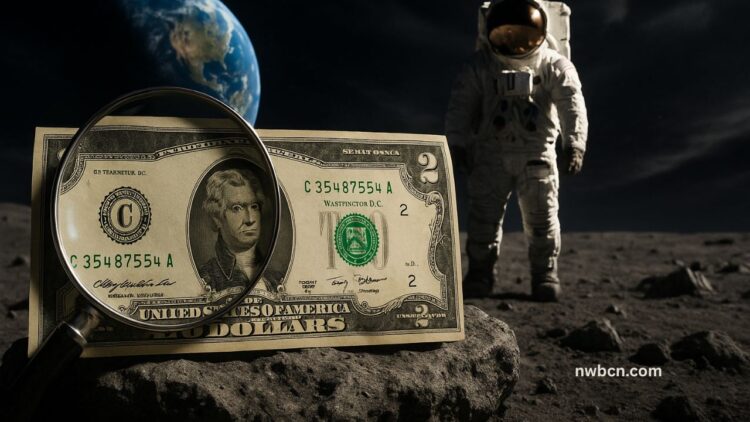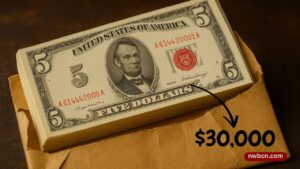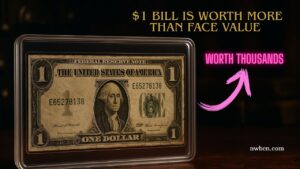A rare $2 bill that orbited the Moon during the Apollo 15 mission has become a prized possession in the world of space memorabilia and numismatics.
Today, this piece of currency—originally worth just $2—is valued at an astounding $75,000. This bill is not just money; it’s a historical artifact that speaks to both America’s space achievements and the unique journeys of everyday objects.
The Apollo 15 Mission and Its Currency Cargo
On July 26, 1971, NASA launched Apollo 15, the fourth mission to land humans on the Moon. Aboard the Saturn V rocket were astronauts David Scott, James Irwin, and Alfred Worden.
Each astronaut was permitted to carry a Personal Preference Kit (PPK)—a small bag filled with personal items or mementos.
Among those items were $2 and $20 bills that the crew members included for sentimental and historical reasons. These bills were not officially sanctioned collectibles, but they would soon become some of the most valuable pieces of space-flown currency ever known.
How the $2 Bill Traveled to the Moon
- Approximately 50 $2 bills were taken aboard the Command Module “Endeavour”, which remained in lunar orbit with Alfred Worden.
- Some bills were unintentionally left inside the Lunar Module “Falcon”, which descended to the Moon’s surface with David Scott and James Irwin.
- These bills were later signed by the crew and accompanied by official flight certificates, authenticating that they had flown aboard Apollo 15.
Each of these details adds layers of significance to the bill’s origin and journey, helping it stand out in the numismatic world.
The Postal Covers Scandal & NASA Policy Shift
Following the Apollo 15 mission, it was discovered that the astronauts had also carried 398 postal covers (envelopes stamped and canceled before or after the mission), some of which were sold to collectors for profit.
This raised concerns about astronauts commercializing their missions, and NASA responded by introducing strict guidelines.
In 1973, NASA banned astronauts from carrying personal items for resale, particularly coins and currency. This sudden restriction made any pre-ban flown bills or coins even more rare and desirable, increasing their long-term value.
Why This $2 Bill Is So Valuable Today
Several key factors contribute to the $2 bill’s staggering valuation of $75,000:
- Historical Significance
It is one of the few known pieces of U.S. currency to orbit or reach the Moon, linking it directly to a pivotal moment in space history. - Rarity
With only about 50 known flown $2 bills, and no more ever to be officially allowed on missions, the item is irreplaceable. - Provenance and Authentication
Each bill comes with a flight certificate and crew member signatures, confirming its authenticity and connection to Apollo 15. - Market Demand
Collectors of both space memorabilia and rare currency actively seek such items, often competing in high-profile auctions to acquire them.
Comparative Market Values
Here’s a comparison of how flown $2 bills stack up against similar memorabilia in the collectibles market:
| Item Type | Quantity Flown | Typical Auction Value | Notes |
|---|---|---|---|
| Flown $2 Bill (Apollo 15, orbit-only) | ~50 | $75,000 | Includes flight certificate & astronaut signatures |
| Flown $2 Bill (Apollo 15, lunar surface) | Unknown | Potentially higher | Rare; left in Lunar Module “Falcon” |
| Buzz Aldrin–Signed $2 Bill (1976) | Not flown | ~$1,250 | Commemorative; not flown |
| Apollo 15 Multi-Signed Postal Covers | 398 | ~$1,500 each | Carried aboard spacecraft but involved in NASA reprimand |
Authentication and Documentation
Each flown $2 bill includes:
- A flight certificate detailing the serial number of the bill.
- Crew signatures (David Scott, James Irwin, and Alfred Worden) on the bill itself or attached documents.
- Sometimes, additional notations or markings that validate its inclusion in the mission’s PPK.
These layers of documentation are crucial. Without them, even a bill with a correct series and serial number may not fetch more than a few hundred dollars.
How Many Are Still Around?
While it’s estimated that around 50 of the flown $2 bills survived and were later distributed or sold, not all of them are publicly known. Some are held in private collections, museums, or with the astronauts’ families. Others have occasionally surfaced at major auctions, typically accompanied by their certification and often reaching five-figure sums.
Why the $2 Bill Was Chosen
The choice of a $2 bill wasn’t random. At the time, the bill was rarely circulated and was often seen as a collector’s oddity even before it went to space. Carrying it aboard the Apollo 15 mission was both practical—due to its small size—and symbolic. By flying it to the Moon, the astronauts elevated a quirky, underused note to iconic status.
Market Activity and Sales History
In recent years, several of these flown $2 bills have appeared in:
- Private auctions
- Space memorabilia expos
- Numismatic trade shows
When one surfaces, it often commands top-tier prices due to:
- The connection to a legendary space mission.
- The document trail confirming authenticity.
- The bill’s pristine or near-mint condition.
Summary Table of Key Facts
| Detail | Information |
|---|---|
| Mission | Apollo 15 – Command Module “Endeavour” |
| Crew | David Scott, James Irwin, Alfred Worden |
| Currency Flown | $2 and $20 bills |
| Estimated Number of Flown $2 Bills | ~50 |
| Lunar Surface Bills | Unknown quantity; possibly more valuable |
| Authentication | Flight certificates, astronaut signatures |
| Current Valuation | $75,000 (auction estimate) |
| NASA Currency Ban | Enacted in 1973 |
The story of the Apollo 15 $2 bill is a perfect example of how history, science, and numismatics collide. What began as a quirky item tucked into an astronaut’s personal kit now commands respect and value as a $75,000 collector’s treasure.
For enthusiasts of space history or rare currency, it represents more than money—it’s a symbol of human ambition, exploration, and the unexpected paths that everyday items can take.
This bill didn’t just change pockets. It changed orbits. And today, it’s one of the most fascinating stories to come out of both the world of currency and the golden age of spaceflight.
Frequently Asked Questions
1. Why did the Apollo 15 astronauts carry $2 bills to the Moon?
The $2 bills were personal items included in their PPKs. They were intended as souvenirs to commemorate the mission and potentially share with family, friends, or collectors.
2. How can you confirm a $2 bill actually went to space?
Authentic flown bills come with a flight certificate listing the serial number, often with astronaut signatures. This documentation is essential to prove its connection to the Apollo mission.
3. Are any other dollar bills known to have gone to the Moon?
Yes, other Apollo missions also carried small mementos, including coins and currency. However, most known flown dollar bills are from Apollo 15, and their sale or display is much more regulated due to post-1973 NASA rules.




